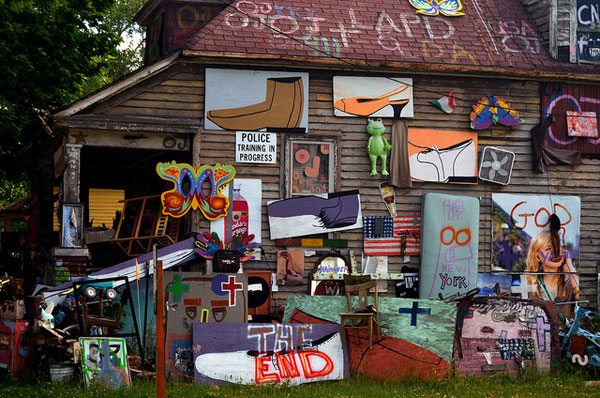
February 6, 2018; NextCity
They say with age comes wisdom. As the eclectic Detroit installation that has always been part experimental community art and part stubborn will to survive turns 30, could the nonprofit have found the key to be a relevant part of the Detroit art scene for the next 30 years?
As it reaches a three-decade milestone that not all nonprofits live to see, the Heidelberg Project is rolling out some big plans, dubbed Heidelberg 3.0. In a most impersonal time in our history, they are looking to redefine what community means. Do they have the chops to pull it off?
Just like the city of Detroit itself, the Heidelberg Project has known both highs and lows. Three decades ago, Tyree Guyton set out to reimagine his dilapidated childhood home on Detroit’s east side, near the intersection of Mt. Elliott Street and Mack Avenue. He painted his grandfather’s house with huge polka dots, and eventually spread out to the abandoned neighborhood around it, using items discarded by residents who had left. He covered entire houses with stuffed animals and records, made political statements about war, and in the process created a living community art installation. It grounded and inspired community artists and attracted thousands of tourists to an area of the city that, by most accounts, even residents worried about walking through in the daytime.
Tyree and his houses-turned-art were the subject of documentaries and both enjoyed celebrity status. However, art is subjective, and not everyone was a fan. The city repeatedly threatened to bulldoze the project throughout the ’90s, and neighbors complained it was an eyesore. The project found new, even stronger foes around 2013, when several of the creations were destroyed in a dozen acts of arson over a two-year period. It is still a crime for which no one has been charged or arrested despite a handsome reward and video footage of a suspect fleeing from one of the fires. Some of the famed installations, like the Soul House, which was covered in hundreds of records, were a total loss to the intentionally set blazes.
Sign up for our free newsletters
Subscribe to NPQ's newsletters to have our top stories delivered directly to your inbox.
By signing up, you agree to our privacy policy and terms of use, and to receive messages from NPQ and our partners.
Nothing lasts forever, sometimes not even a beloved nonprofit, program, or funding source. It looked like the Heidelberg Project might fade into the backdrop of a noisy city in a constant cycle of urban reinvention. Even for a strong nonprofit, withstanding the destruction of over half of your instillation is hard to come back from.
Instead of fading, though, Tyree and the Heidelberg are gunning for a comeback. “Our vision has always had to do with bringing hope, new life to the neighborhood,” says the Heidelberg Project’s executive director and Guyton’s wife, Jenenne Whitfield.
NextCity reported that their new vision looks like “creating an inclusive community, where the properties that became the project’s infamous installations can serve not just as pieces of reclaimed art, but as dwellings where artists can live and take part in neighborhood investment.” The artists will live in residence in the houses/art projects and contribute towards the nonprofit’s mission. The idea is gaining traction in the form of funding, with $110,000 in support from an online drive and the Erb Family Foundation stepping in to match.
The reimagination of the space and the possible revitalization of the neighborhood surrounding it is tantalizing for many residents. Since, with the exception of one house that housed a gift shop and office, the project never involved tours of the homes themselves, only the exteriors, the interiors remained unused. There is also the kitsch factor of living in a part of history. Many artists and fans would pay to stay there.
Still, others will surely raise eyebrows about how this will play out. There could arguably be some safety concerns about taking up residence in an art project that has already endured a dozen arson attempts. Also, Heidelberg is in one of Detroit’s oldest African American neighborhoods, McDougall-Hunt, where poverty rates are high—about 40 percent of the population falls below the poverty line, which is $12,140 for an individual. NextCity reports that many Detroit neighborhoods are either being neglected or gentrified during expensive redevelopment by outsiders who care little about the city and its rich and diverse heritage. Though the development is sorely needed, could 3.0 spark some homegrown grit and revitalization that would sidestep the pitfalls?—Carrie Collins Fadell











